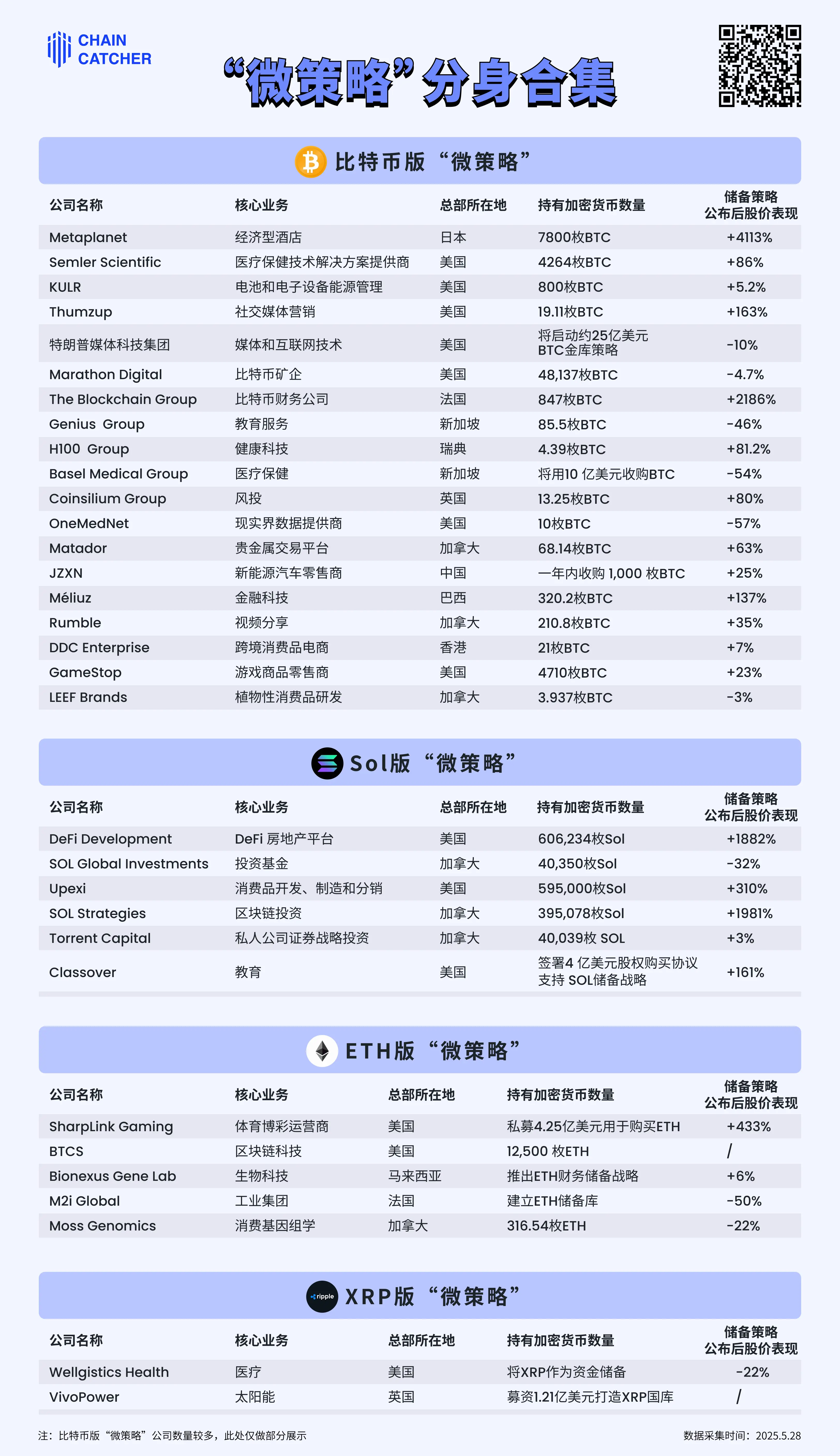Author: Fairy, ChainCatcher
Editor: TB, ChainCatcher
The market always creates "stories" in unexpected ways.
From MicroStrategy to ETH version, SOL version, XRP version "MicroStrategy," the previously overlooked micro-cap companies in the U.S. stock market have become carriers and amplifiers of new stories.
The alternative integration trend between crypto assets and traditional stock markets is quietly spreading. Is this a further evolution of crypto financialization, or a narrative bubble built on high leverage?
MicroStrategy Avatar Guide: Who are the Coin-Holding Doubling Stocks?
The crypto treasury strategy has become a prominent trend in the capital market. According to Bitcointreasuries data, there are currently 211 entities globally holding over 3.37 million bitcoins, with publicly traded companies holding about 800,000 bitcoins, and this number continues to grow. Recently, Trump Media & Technology Group, under Trump, has also entered the market, raising about $2.5 billion through private placement to establish a bitcoin treasury.
To further explore, we have compiled a list of "MicroStrategy" avatar companies:

Many companies in the image were performing poorly or even facing financial difficulties before venturing into crypto assets. For example, Upexi saw a decline in financial revenue and an increase in net losses in the second half of 2024. However, since announcing its reserve strategy, its stock price has risen over 300%. Similar cases are not uncommon; some companies have achieved several times, or even tens of times, increases in the capital market through this strategy.
At the same time, multi-currency versions of "MicroStrategy" are continuously emerging. Clean energy solutions provider Worksport has invested its cash reserves in BTC and XRP; e-commerce company GD Culture Group has secured a $300 million financing commitment to purchase bitcoin and TRUMP as long-term reserve assets. These trends indicate that more and more traditional companies are attempting to achieve strategic transformation and market repricing through crypto assets.
Generalization of Play: Borrowing Coins to Trade Stocks, Borrowing Stocks to Support Coins
The "MicroStrategy" path essentially has a very low threshold: continuously issuing stocks, issuing bonds to complete financing, and then allocating the funds to crypto assets, using financial reports as valuation anchors to feed back into stock price performance. The difference lies in who has stronger fundraising capabilities, which coins to allocate, and whether to choose staking for returns, among other details.
Two days ago, SharpLink Gaming announced a $425 million private placement and included ETH in its treasury, becoming a typical case of this model: raising funds at a price below net asset value, purchasing and staking ETH; when the stock price exceeds the net value of ETH per share, refinancing occurs, and this cycle continues.
It is worth noting that the investors in this round are almost exclusively established institutions like ConsenSys, ParaFi, and Pantera, which heavily invested in Ethereum in its early days. SharpLink previously had a market value of only about $10 million and only needed to issue 69.1 million new shares at a low price to transfer 90% of control to the "Ethereum camp."
To some extent, this type of operation is similar to the operational logic of the previous wave of crypto spot ETF applications: companies collaborate with token projects to create expectations and valuation bubbles through capital market means. "Buy coins—show off—trade stocks" has also become a new path for token projects to leverage the U.S. stock market. Crypto KOL AB Kuai.Dong revealed that in addition to the officially announced ETH and SOL MicroStrategy plans, there are rumors of 6-7 projects in the shell-seeking and acquisition stage that have not yet been disclosed. Moreover, VC and market makers are also quietly transforming, turning to find U.S. stock shells for acquisition, fundraising, and buying coins.

Mainstreaming or Capital Illusion?
The stock price curve injects on-chain volatility; the flywheel is turning but the direction is unclear. Can these operations truly function long-term and create structural value, or are they merely a capital illusion under exquisite packaging?
Crypto KOL @lowstrife provided his warning: these so-called "crypto reserves" are essentially a destructive leverage structure, whose essence is to provide cash flow for token accumulation by continuously diluting the equity of common stockholders. This path operates particularly smoothly for MicroStrategy, provided that its stock price is above the value of its held bitcoins (mNAV > 1). Once it falls below this balance point, the entire flywheel may stall or even reverse.
However, is it really feasible to replicate this model? Bloomberg columnist Matt Levine pointed out that MicroStrategy has first-mover advantages, strong investor relations, effective market narratives, and systemic channels supported by inclusion in ETFs and indices. Ironically, this logic is now being copied by a group of "small MicroStrategy companies," yet the market seems to have premium expectations for each newcomer. Matt wrote: "The current situation is like the crypto circle is continuously playing the U.S. stock market, and the U.S. stock market keeps falling for it."
From the community perspective, the sustainability of this structure is also in doubt. Community member @0xdafu believes that the continued operation of this structure relies on the relative stability of the underlying assets. Bitcoin can carry "infinite imagination," but stock market valuations cannot be infinitely overdrawn on "market dream rates." Community user @connect1998 further likened this cycle to a Evergrande-style capital game: asset collateral leads to financing, financing further amplifies asset allocation, ultimately accumulating into massive debt and bubbles. Once the market no longer buys in, the consequences may not only be a halving of valuations but also a systemic pullback.

Stories can be replicated, but value cannot be fabricated.
When the logic of capital entangles the ideals of crypto, when the banner of mainstreaming transforms into a leverage-driven financial model, is this evolution, or another form of "selling out"?
免责声明:本文章仅代表作者个人观点,不代表本平台的立场和观点。本文章仅供信息分享,不构成对任何人的任何投资建议。用户与作者之间的任何争议,与本平台无关。如网页中刊载的文章或图片涉及侵权,请提供相关的权利证明和身份证明发送邮件到support@aicoin.com,本平台相关工作人员将会进行核查。




